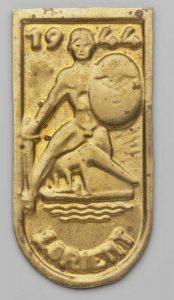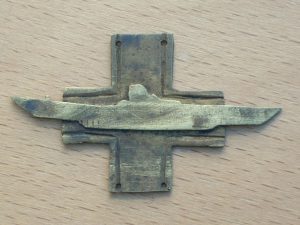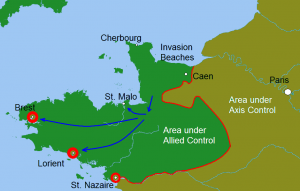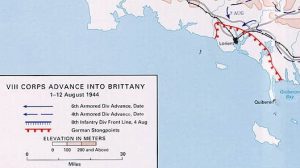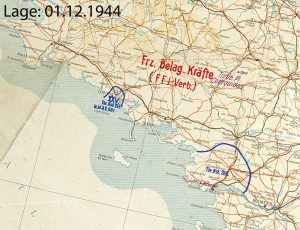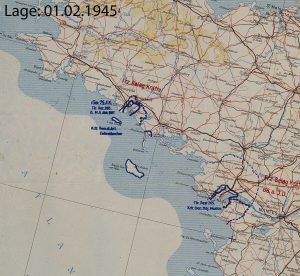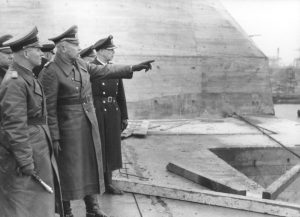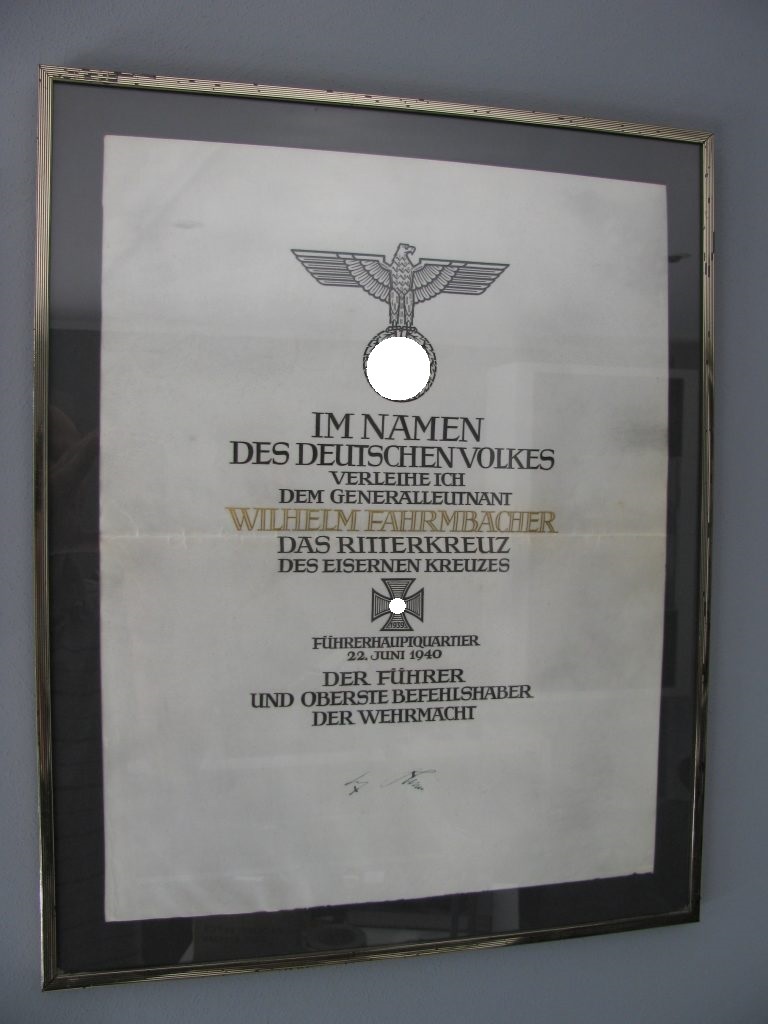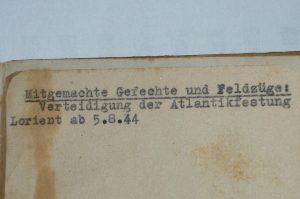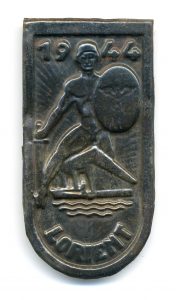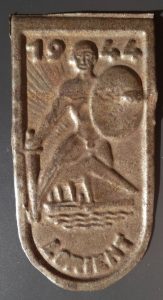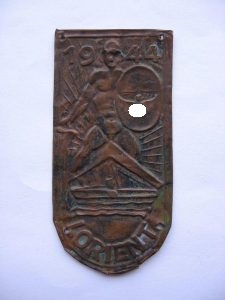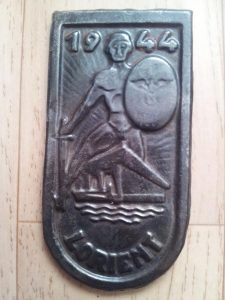Here we can see in the photo a German submarine type XXI, one of the most modern submarines of its time.
Submarines of this type were manufactured from April 1944 to January 1945 at the shipyards of Blohm & Voss in Hamburg, at the Deschimag AG Weser in Bremen and by the Schichau Works in Gdansk in a number of about 131 and also after the war by the British, French and Soviets continue to be used.
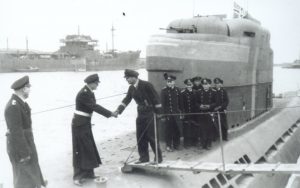
The boat shown here in the picture is supposed to be U 3034, which was layed on keel an built at the Deschimag AG Weser in Bremen on November 14th, 1944 and could not be put into service until March 31st , 1945 due to damage caused by an air raid. It served until May 05th, 1945, the day of his self-sinking as a training boat of the 4th U-Flotilla (training flotilla) and was therefore never in combat.
Commander of this boat were until the beginning of April 1945 First-Lieutenant Wilhelm Prehn and later First-Lieutenant Horst Willner, who sank the boat on the morning of May 5th, 1945 in the Geltinger Bay, so it could not fall into Allied hands.
A total of 47 submarines were sunk in the bay on the night of May 4th to May 5th due to the so-called „Regenbogen-Befehl“ (“Rainbow” Order). U 3034 was lifted in 1946 and scrapped.
In the photo, among other things, several officers, probably crew members of the boat, at the front of the command tower are recognizable.
Standing on the access bridge, a lieutenant-commander is recognizable, who probably visits the boat and its crew.
He wears as decorations visible the ‘Minesweeper War Badge’ and the ‘Destroyer War Badge’.
The officer who welcomed the lieutenant-commander on board might be the commander, that is, Prehn or Willner.
First-Lieutenant Horst Willner later became known by the fact that under the command of U 3505 between 22.03.-26.03.1945 from Gotenhafen/Gdansk and Hela over 50 refugees (other sources also mention 110 civilians and as a period 28.03.-02.04.1945 ), including women, children and youth of the HJ (Hitler Youth) took on board to bring them to Lübeck Travemünde and thereby save from the advancing Soviets. Among the refugees were his wife and his newborn daughter.
After U 3505 had been sunk on April 3rd, 1945 by a heavy air attack in the port of Kiel, took over Willner and his crew substitute U 3034.
The boat had two Flak towers, each with 2x 2cm Flak C / 38, which were installed in the front and rear of the command tower and were able to swivel horizontally up to 240 ° and vertically up to + 45 ° / -5 °.
The boat is marked on the tower with large stripes, alongside and vertically, by means of yellow paint.
It has been preserved with ex U 2540 until today only a single submarine of this type and can be visited in Bremerhaven as a museum ship.
The location and the date on which the photo was taken, we are not yet known, so we would like more information would be very welcome.
______________________________________________________________________
Wir erkennen hier auf dem Foto ein deutsches U-Boot vom Typ XXI, einem der modernsten Unterseeboote der damaligen Zeit.
U-Boote dieses Typs wurden ab April 1944 bis Januar 1945 bei den Werften von Blohm & Voss in Hamburg, bei der Deschimag AG Weser in Bremen und durch die Schichau-Werke in Danzig in einer Stückzahl von etwa 131 gefertigt und auch nach Kriegsende durch die Briten, Franzosen und Sowjets weiter verwendet.

Bei dem hier im Bild erkennbaren Boot soll es sich um U 3034 handeln, welches bei der Deschimag AG Weser in Bremen am 14.11.1944 auf Kiel gelegt und aufgrund von Beschädigungen durch einen Luftangriff erst am 31.03.1945 in Dienst gestellt werden konnte. Es diente bis zum 05.05.1945, dem Tag seiner Selbstversenkung als Ausbildungsboot der 4. U-Flottille (Ausbildungsflottille) und war somit nie im Kampfeinsatz.
Kommandanten dieses Bootes waren bis Anfang April 1945 Oberleutnant Wilhelm Prehn und anschließend Oberleutnant Horst Willner, der das Boot am Morgen des 5.Mai 1945 in der Geltinger Bucht versenkte, um es nicht den Alliierten in die Hände fallen zu lassen. Es wurden in der Bucht insgesamt 47 U-Boote in der Nacht vom 4. zum 5. Mai aufgrund des sogenannten “Regenbogen-Befehl” selbst versenkt. U 3034 wurde 1946 gehoben und abgewrackt.
Auf dem Foto sind unter anderem mehrere Offiziere, vermutlich Besatzungsmitglieder des Bootes, am vorderen Bereich des Turmes erkennbar.
Auf der Zugangsbrücke stehend, ist ein Kapitänleutnant erkennbar, der vermutlich das Boot und seine Besatzung besucht. Er trägt als Auszeichnungen das Kriegsabzeichen für Minensuch-, U-Boot-Jagd- und Sicherungsverbände und das Zerstörer-Kriegsabzeichen. Bei dem Offizier der den Kapitänleutnant an Bord begrüßt, könnte es sich um den Kommandanten, also um Prehn oder um Willner handeln.
Oberleutnant Horst Willner wurde später dadurch bekannt, dass er unter dem Kommando von U 3505 zwischen 22.03.-26.03.1945 von Gotenhafen/Danzig und von Hela über 50 Flüchtlinge (anders lautende Quellen nennen auch 110 Zivilisten und als Zeitraum 28.03.-02.04.1945), darunter Frauen, Kinder und Jugendliche der HJ an Bord nahm, um sie nach Lübeck-Travemünde zu bringen und dadurch vor den anrückenden Sowjets zu retten. Unter den Flüchtlingen befanden sich auch seine Frau und seine neugeborene Tochter. Nachdem U 3505 am 03.04.1945 durch einen schweren Luftangriff im Hafen von Kiel versenkt worden war, übernahm Willner und seine Besatzung ersatzweise U 3034.
Das Boot verfügte über zwei Flaktürme mit jeweils 2x 2cm Flak C/38, die im vorderen und hinteren Bereich des Kommandoturmes verbaut und horizontal bis zu 240° und vertikal bis zu +45°/-5° schwenkbar waren. Das Boot ist am Turm mit großen Streifen, längsseits und senkrecht, mittels gelber Farbe markiert.
Es hat sich mit ex U 2540 bis heute nur ein einziges U-Boot dieses Typs erhalten und kann in Bremerhaven als Museumsschiff besichtigt werden.
Der Aufnahmeort und das Datum an dem das Foto entstanden ist, sind uns bisher nicht bekannt, sodass uns weitere Informationen hierzu sehr willkommen wären.
Text made by R.A.
Copyright at bacuffz.com
